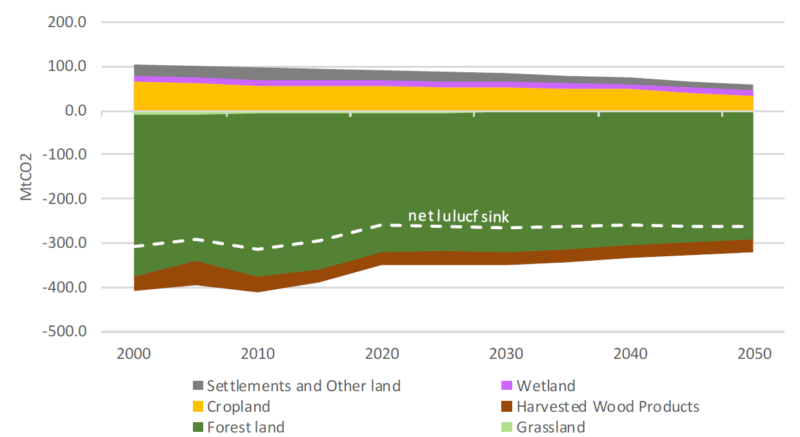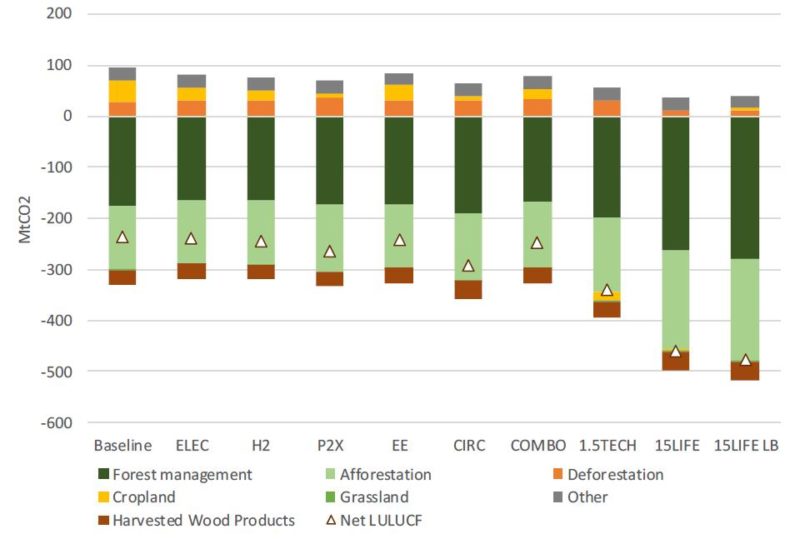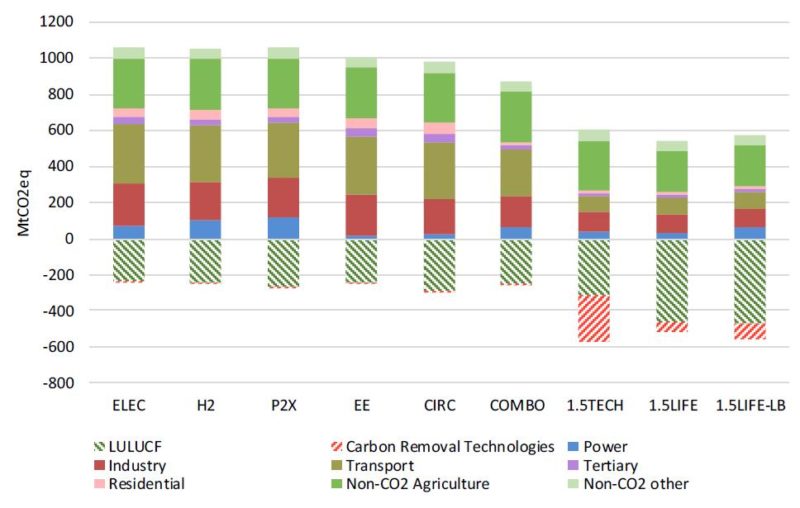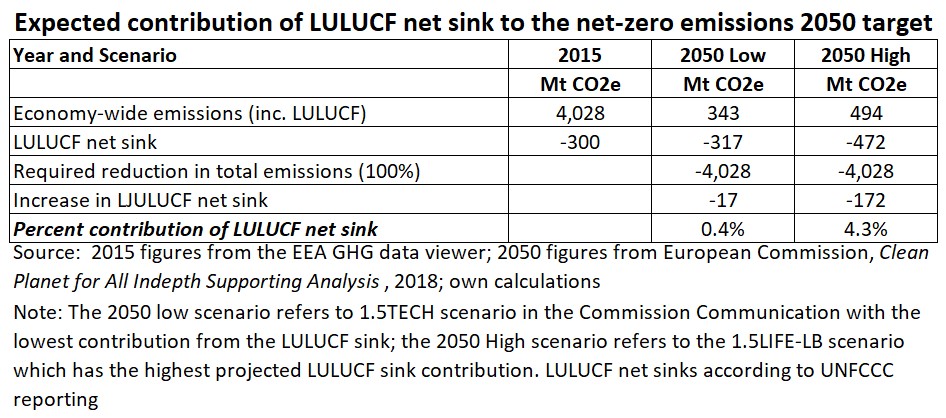In its Decision adopting the Paris Agreement in 2015, the Conference of the Parties (COP21) of the United Nations Framework Convention on Climate Change (UNFCCC) decided to convene a facilitative dialogue among Parties in 2018 to take stock of the collective efforts of Parties in relation to progress towards the Agreement’s long-term goal and to inform the preparation of nationally determined contributions (NDCs) (Para. 20). It also asked those Parties that had submitted intended NDCs prior to the adoption of that Decision, such as the EU, “to communicate or update by 2020 these contributions” (Para. 24). Furthermore, it requested Parties to communicate to the secretariat , by 2020, mid-century, long-term low greenhouse gas emission development strategies in accordance with Article 4, paragraph 19, of the Agreement (Para. 35). The EU must thus submit both an enhanced NDC and a long-term strategy to the UNFCCC next year.
In this post, I discuss how the LULUCF sector is treated in the EU’s long-term climate strategy. In my previous post, I described the way the LULUCF sector is included in the 2030 Climate and Energy Framework. The EU objective is that the land sector should be in balance in terms of credits and debits (as accounted for using rules set out in the LULUCF Regulation 2018/841) – the ‘no-debit’ rule. The rules also open the possibility that a capped credit surplus up to 280 million tonnes CO2 equivalent (CO2e) in the LULUCF sector can be used to offset emissions in the effort-sharing sectors – a ‘limited fungibility’ rule. My assumption is that these commitments will be included in the EU’s enhanced NDC when it is submitted next year. But other permutations are possible. I argue below for consistency in the way the EU’s commitments are framed in its enhanced NDC and in its long-term strategy. However the commitments are framed, contrary to the claims sometimes made about the great sequestration potential of the land sector, I show that the LULUCF sector will play a rather minor direct role as a sink (that is, not counting its contribution to emissions substitution in the non-land sectors) in helping the EU achieve its net-zero emissions ambition.
Political context for the EU’s long-term climate strategy
The EU’s existing long-term commitment, adopted by the European Council in 2009 in the light of the IPCC’s Fourth Assessment Report which was the latest science at that time, and in the run-up to the COP15 conference in Copenhagen, is to reduce emissions by 80-95% in the context of necessary reductions, according to the IPCC, by developed countries as a group. This was supported by a long-term low-carbon development strategy set out in the Commission Communication A Roadmap for moving to a competitive low carbon economy in 2050 published in 2011 which included several scenarios showing how this objective could be achieved.
This commitment was the basis for the EU’s intended Nationally Determined Contribution (NDC) submitted to the UNFCCC in May 2015. This took the form of a flimsy, three-page table which may have fulfilled the formal submission requirements but left a lot to be desired as a communication tool (though the Latvian Presidency did provide a more colourful infographic version at the same time).
To fulfil the COP21 mandate, the European Council invited the Commission on 22 March 2018 to present, by the first quarter of 2019, a proposal for a strategy for long-term EU greenhouse gas emission reductions in accordance with the Paris Agreement, taking into account the Member State ambitions in their integrated national energy and climate plans. This mandate was subsequently included and spelled out in Article 15 on long-term strategies in the Governance Regulation 2018/1999 adopted in December 2018.
The Commission response was set out in its vision strategy A Clean Planet for All published in November 2018 just prior to the December 2018 COP24 Climate Change Conference in Katowice. It argued that it is now time to update the evaluation of the EU’s possible contribution to global action, following the entry into force of the Paris Agreement, the adoption of legislation to achieve the 2030 Framework and new scientific evidence, as synthesised in the IPCC Special Report on 1.5°C. The Strategy calls for a climate-neutral Europe by 2050.
Following the presentation of the Commission Communication, the European Council meeting in December 2018 invited the Council to work on the elements it outlined and committed ‘to provide guidance on the overall direction and political priorities’ in the first semester of 2019, to enable the European Union to submit a long term strategy by 2020 in line with the Paris Agreement.
Since then, the Commission’s Strategy has been discussed by various Council formations, including the AGRIFISH Council in May 2019. The European Parliament adopted a resolution in March 2019 welcoming the Strategy, which calls for an overarching approach towards achieving net-zero greenhouse gas emissions by 2050 and advocates a 55% reduction of EU emissions by 2030.
The European Council discussed the Strategy again at its March and June 2019 meetings. At the June meeting, Member States were divided on whether to adopt an EU goal of net zero emissions by 2050 or not (a footnote to the conclusions noted that a “large majority” of Member States supported this objective of climate neutrality by 2050, whereas four Member States held out against any mention of a specific date). The European Council stated that it would finalise its guidance before the end of the year. Finland, which took over the Council Presidency on 1 July, has promised in its Presidency Programme to “continue the work on defining the key elements for the EU’s long-term climate strategy for 2050 in the European Council by the end of 2019 at the latest”.
At the same time as the EU is preparing its long-term strategy, Member States are required under the Governance Regulation to be doing the same in parallel with the preparation of their integrated national energy and climate plans (NECPs). According to the preamble to the Regulation (Recital 36):
Member States should develop long-term strategies with a perspective of at least 30 years contributing to the fulfilments of the Member States’ commitments under the UNFCCC and the Paris Agreement, in the context of the objective of the Paris Agreement of holding the increase in the global average temperature to well below 2 °C above pre-industrial levels and to pursue efforts to limit the temperature increase to 1,5 °C above pre-industrial levels and achievement of long-term GHG emission reductions and enhancements of removals by sinks in all sectors in line with the Union’s objective. Member States should develop their strategies in an open and transparent manner and should ensure effective opportunities for the public to participate in their preparation. Their integrated national energy and climate plans and the long-term strategies should be consistent with each other.
Although there is considerable overlap, these are two separate plans each with their own template and structure that Member States should follow (the structure for the NECPs is set out in Annex 1 of the Governance Regulation, and the structure for the long-term decarbonisation strategies is set out in Annex 4 of the Regulation). To date, there seems to be no publicly available information on the status of these national long-term strategies on the European Commission website. They should be delivered by the end of this year along with the revised national energy and climate plans (NECPs).
A number of Member States have submitted long-term strategies (LTS) to the UNFCCC in line with the call in the Paris Agreement (Czech Republic, France, Germany, UK at the time of writing). These were submitted prior to adoption of the Governance Regulation so they are not set out in the format prescribed in Annex 4. The Commission notes that other Member States work intensively on them. Perhaps optimistically, it states that;
The 2030 national objectives set in the Plans will play a key role for the national LTS and vice versa and the long term decarbonisation perspective will play a key role for the NECPs. The requirements in the Governance Regulation of public participation and consultation as regards both the national plans and the long-term strategies should ensure that local and regional actors are involved in their development, contributing to the broad acceptance of the NECPs and the national LTS.
The latest piece in the jigsaw is Commission President-elect von der Leyen’s commitments in her Political Guidelines for the next Commission 2019-2024 presented just before her nomination was confirmed by the European Parliament on 16 July. Under the heading of a European Green Deal, the President-elect committed to proposing the first European climate law to enshrine the 2050 climate-neutrality target into law within the first 100 days of taking office. She also proposed more ambitious 2030 climate targets, wanting to reduce emissions by at least 50% by 2030 (compared to 1990).
In addition, she recognised that to achieve real impact the world has to move together. She therefore proposed that the EU should lead international negotiations to increase the level of ambition of other major emitters by 2021. By this date, she committed to putting forward a comprehensive plan to increase the European Union’s target for 2030 towards 55% in a responsible way. While this percentage reduction echoes the Parliament’s demand, the proposed timetable means that it is not intended to be included in the EU’s enhanced NDC to be submitted in the early part of next year. However, were it to be accepted (which would imply adjusting relevant domestic EU legislation to comply with the changed headline target, as well as a new effort sharing exercise among Member States and/or sectors which could take several years to finalise), this could be part of the EU’s ‘ratcheting up’ of its ambition in the context of the first Global Stocktake under the Paris Agreement which is scheduled for 2023 and the submission of its second NDC in 2025.
LULUCF in the A Clean Planet for All Communication
The Commission’s Communication on its long-term strategy presents options and related scenarios for long-term ‘climate neutrality’, with a view to achieving a net reduction of greenhouse gas emissions of between 80% and 100% by 2050. These are compared to a Baseline scenario which is an updated version of its Reference Scenario 2016. One significant update is a more extended treatment of the LULUCF sector in the latest version.
The land use and forestry sector keeps its role of net carbon sink in the Baseline (see figure below). However, the sink is projected to decrease from about 300 MtCO2 in 2015 to 260 MtCO2 in 2050 due to the ageing of the forest and an increasing mobilisation of forest biomass, mainly for material use (industrial roundwood, sawnwood, wood panels, paper, paperboard). These numbers refer to UNFCCC inventory data, not accounting in terms of debits and credits (see my previous post for an explanation of this distinction).

Source: European Commission, Clean Planet for All, In-depth analysis in support of the Commission Communication COM (2018) 713
However, the line for the net LULUCF sink after 2020 looks suspiciously flat (compare with Figure 70 in the Reference Scenario 2016), as if the authors of the Baseline have carried over the ‘no-debit’ rule which refers to accounted credits and debits to the UNFCCC reporting of emissions and removals. If anyone is aware of a source which describes how the LULUCF sink is modelled in GLOBIOM in the Baseline, please let me know.
The Communication sets out nine different scenarios which achieve net emissions reductions of between 80% (consistent with the 2° target in the Paris Agreement) and 100% (consistent with the 1.5° target). The latter implies net-zero emissions by 2050. The role of the LULUCF sector in the nine scenarios is shown in the figure below. The three scenarios on the right labelled 1.5*** all include a specific incentive to enhance the LULUCF sink, varying between €30/tCO2e and €80/tCO2e. They differ in the relative contributions of carbon dioxide removal options, changes in consumer behaviour and the land sink. In absolute terms, the land sink grows from 236 Mt CO2e in 2050 in the Baseline (note that this figure is given as 260 Mt CO2e when describing the Baseline on p. 51 of the Communication) to between 317 Mt and 472 Mt CO2e under the net-zero emission scenarios (Table 9 in the Communication).

Source: European Commission, Clean Planet for All, In-depth analysis in support of the Commission Communication COM (2018) 713, based on GLOBIOM modelling.
Evaluating how LULUCF is included in the EU’s long-term climate strategy
The LTS uses reported emissions/removals rather than accounted credits/debits. We underline that the EU’s long-term strategy assesses the potential contribution of the LULUCF sector to a net-zero emissions economy in 2050 on an emissions/removals (UNFCCC inventory reporting rules) basis, while the EU’s enhanced NDC is likely to use the debit/credit basis (LULUCF Regulation rules) for its 2030 target. Whether one formulation sets a higher level of ambition than another depends on the dynamics of the forest stock in 2050. If the forest stock is still ageing and this is reflected in the forest reference level (FRL – see previous post for an explanation), then LULUCF accounting would be less ambitious than UNFCCC inventory reporting, but the reverse would also be the case. As FRLs for the next thirty years may be difficult to establish (the Governance Regulation asks Member States to prepare these on five-yearly intervals), it is understandable why UNFCCC inventory reporting is used in preparing the scenarios.
While any differences caused by the use of different accounting rules are small given the overall challenge involved in reaching a net-zero emissions target, it would not be desirable that targets set in the NDC are based on a different methodology to that used in deriving the EU’s long-term strategy from a transparency point of view. The Commission is asking Member States to use the policy-accounting rules for the LULUCF sector in establishing their 2030 targets in their national energy and climate plans. It will be worth watching how Member States report their LULUCF sinks/sources in their accompanying long-term strategies.
According to the Commission’s analysis, under the scenarios consistent with net-zero emissions in 2050, decarbonisation of the economy will lead to a reduction of 91-94% in emissions compared to 1990 (with some contribution from negative emissions technologies), with the balance offset by the land sink (Table 9 in the in-depth supporting analysis and the figure below).

Source: European Commission, Clean Planet for All, In-depth analysis in support of the Commission Communication COM (2018) 713, based on GLOBIOM modelling.
The LTS assumes complete fungibility between LULUCF sinks and other emissions. In contrast to the policy-accounting rules which set a cap on the extent to which land sinks can be used to offset emissions in other sectors, the Commission’s net-zero emissions long-term strategies implicitly assume complete fungibility. There are arguments on both sides.
The main argument in favour of full fungibility is that a tonne of carbon sequestered in the land sink is equivalent to reducing emissions by a tonne of carbon from the atmosphere’s point of view and should be treated equivalently in the accounts. From a practical perspective, setting a cap may discourage governments from incentivising certain low-cost sequestration initiatives, such as rewetting organic or peatland soils, if they find they cannot make use of the credits because of the cap.
There are various arguments on the other side. Land removals have some characteristics (reversibility, saturation, measurement uncertainty) which lead people to question whether indeed a tonne of carbon sequestered should be treated as equivalent to a tonne of carbon emitted. In the debate around the 2030 Climate and Energy Framework, where the reduction target was first set before the LULUCF rules were agreed, it was objected that allowing fungibility between the land sector (known as a net sink) and other sectors would dilute the necessary incentive to reduce emissions from fossil fuel energy sources. The fear that Member States would game the LULUCF rules, particularly when establishing FRLs for forest management, was also a factor in limiting access to land sink credits by the effort-sharing sectors.
The LTS foresees a minor role for the LULUCF sector in meeting net zero emission targets. Strong statements are sometimes made about the important contribution that the LULUCF sector can make to mitigating climate change. Although there seems to be significant potential on a global scale, through afforestation, reforestation and the restoration of degraded soils, the expected potential contribution in the EU according to the Commission’s long term strategy is surprisingly limited. The Commission’s modelling is not, of course, an estimate of the technical potential to sequester carbon using natural sinks, but rather reflects what it projects can happen based on assumed policies, carbon prices and particularly the demand for biomass. The following table shows the expected net contribution under two scenarios.

The table takes 2015 as the base year (because the LULUCF sink has been roughly constant since 1990, the LULUCF contribution to the net-zero emissions target would be smaller if the calculations were done relative to a 2005 or 1990 base year). In 2015, total net emissions amounted to 4,028 Mt CO2e. If we are to reach net-zero emissions in 2050, this is the total reduction which must be achieved.
The table shows the net contribution expected from the LULUCF sector in the two 1.5° scenarios with the lowest and highest LULUCF sinks, respectively, in the Commission Communication. The LULUCF contribution varies between 0.4% in the Low scenario to 4.3% in the High scenario.
The fact that the net land sink contribution to the overall net-zero emissions target is limited does not mean that activities to enhance the LULUCF sink are not important. Indeed, in the scenarios without specific incentives to enhance sinks the size of these sinks is expected to fall. Forest biomass can substitute for fossil energy and materials (through harvested wood products) in the non-land sector but is only partially credited for these activities in the LULUCF accounts. The expected increase in the demand for bioenergy will put pressure on forest resources in particular, which will require improved management of forest resources, additional afforestation and further sequestration in agricultural land if the overall LULUCF sink is to be maintained or indeed enhanced.
Conclusions
The treatment of the land sector in GHG accounting is a sensitive issue because the use of land affects not only GHG emissions but also its functions in providing food and material biomass, habitats for biodiversity, and other ecosystem services. This post sets out the political context to the preparation of the EU’s long-term strategy to reach net-zero emissions by 2050 and the role expected of the land sector in this transition.
The post points out that treatment of the LULUCF sector in the Commission’s long-term strategy and in its 2030 Climate and Energy Framework are not consistent. This should be clarified when the EU submits its enhanced NDC early next year containing targets both for 2030 and 2050. Even if the EU uses policy accounting rules in its domestic framework to better incentivise Member States, there is a case for reporting its 2030 target in UNFCCC inventory terms. I am aware that this issue led to long discussions over many years when formulating LULUCF rules for the Kyoto Protocol and of the arguments on both sides, but an inconsistency in using two different methodologies for climate strategies submitted to the UNFCCC at the same time would be troubling.
Apart from this transparency point, the main message is that sequestration in the land sector cannot replace the need for deep decarbonisation in the energy, transport, heating and cooling and industrial sectors which must remain the top priority. Forest biomass for bioenergy purposes is expected to contribute to fossil fuel substitution although it does not get credited for this activity in the LULUCF accounts. Additional efforts through improved forest management, afforestation and sequestration in agricultural soils will be needed to avoid a fall in the size of the sink and to hopefully increase it slightly. The projected net changes are in any case small in relation to the overall scale of the challenge.
This post was written by Alan Matthews
Picture credit: Kate McGregor, used under a Creative Commons CC by 2.0 licence


